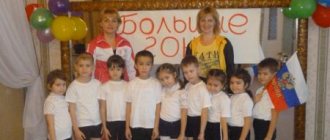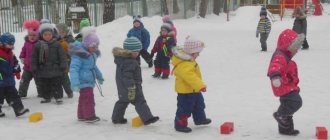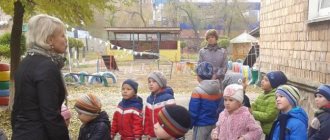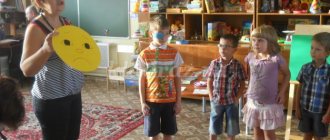GCD in the senior group “Physical Education”
- Guys, there are birds that winter, and also... (Children's answers). Right. And soon they will fly to us from warmer climes.- Do you think it is easy for birds to fly such a distance? (Children's answers).
Many of them do not make it and die on the way. They probably have to exercise their wings and legs. Let's imagine how birds prepare for flight, and at the same time let's exercise ourselves, because doing exercises is so good for health.
— First exercise “Preparing for flight.”
— Starting position: o.s., arms along the body.
— Execution: on the count of 1, lower your chin to your chest, on the count of 2, throw your head back, on the count of 3, to the right, on the count of 4, tilt your head to the left.
- Accept the starting position!
- Start the exercise!
- Second exercise: “Let's check the wings.”
I.p.: o.s., arms along the body.
- Execution: on the count of 1 - arms forward, on the count of 2 - arms up, on the count of 3 - arms to the sides, on the count of 4 - arms down, return to i. P.
- Accept the starting position!
- Start the exercise!
— Third exercise “Looking for grains.”
— Starting position: feet shoulder-width apart, arms along the body.
— Execution: on the count of 1, bend forward, touch your toes with your hands, on the count of 2, straighten up, return to i. P.
- Accept the starting position!
- Start the exercise!
— Fourth exercise “Prepare for flight.”
IP: feet shoulder-width apart, hands to shoulders.
— Execution: on the count of 1 – turn to the right, move your right hand to the side, look at it; on the count of 2 - return to IP. Also perform to the left.
- Accept the starting position!
- Start the exercise!
— Fifth exercise “Keeping balance.”
I.p.: feet hip-width apart, hands on the belt.
— Execution: on the count of 1, slightly raise your straight right leg forward, on the count of 2, draw circles in the air, on the count of 4, return to i. n. Alternately with the right and left foot 4 times.
- Accept the starting position!
- Start the exercise!
-Sixth exercise “Flapping wings under the foot.”
I.p.: standing, feet hip-width apart, hands on the waist.
— Execution: on the count of 1, bend the leg at the knee, clap under the knee, on the count of 2 and. P.
- Accept the starting position!
- Start the exercise!
Seventh exercise “Birds are jumping.”
IP: legs together, arms along the body.
Execution: on the count of 1, jump your legs apart - arms to the sides, on the count of 2 - return to i. P.
- Accept the starting position!
- Start the exercise!
Eighth exercise: “Let’s blow on feathers.”
I.p.: o.s., arms along the body.
Execution: inhale through the nose, spread the arms to the sides - bend forward and exhale long through the mouth, with a stream of air on the lowered arms .
- Accept the starting position!
- Start the exercise!
-Well done! And now we will divide into two teams “Sparrows” and “Jackdaws”. And we will do types of movements in subgroups.
Forms and types of educational activities with preschool children in the educational field “Physical Education”
Use different ways to organize children: frontal, group, individual, shift, circuit training;
When performing a set of general developmental exercises, pay special attention to children’s posture and breathing. Provide the name of the exercises, change of starting positions for each exercise, varied use of methods (demonstration by the teacher or child, verbal explanation, etc.), rhythmic accompaniment (music, sound, counting, word, free tempo).
Strive to implement a differentiated approach in the main types of movements and game exercises.
When studying complex material, you should create a holistic idea of the entire motor act and perform the exercise in general terms. This requires a clear presentation at a certain pace. Next, it is important to work out the technique of performing each element of the movement and develop in children a sense of self-control over their motor activity.
In order to consolidate and improve acquired motor skills and abilities, provide children with the opportunity to independently reproduce exercises.
Pay special attention to creating high variability in pedagogical conditions, which contributes to more effective implementation of children’s motor activity (due to the novelty of exercises, the introduction of new aids and objects, and the gradual complication of motor tasks).
Activate the mental activity of each child. To do this, you should use spatial terminology, provide the child with an independent choice of how to perform actions, ask leading questions, create search situations, etc.
Create special situations to demonstrate the child’s strong-willed qualities, determination, courage, and resourcefulness.
GCD forms for the educational field “Physical Education”:
Junior preschool age
plot-game -
built on one plot (“Zoo”, “Cosmonauts”, etc.). The tasks of improving motor skills and abilities, cultivating interest in activities, physical exercises, motor independence, etc. are solved.
thematic -
dedicated, as a rule, to one type of sports game or exercise: skating, skiing, elements of volleyball, etc. new types of sports exercises and games are learned and skills are consolidated in already mastered movements.
classical
Senior preschool age
Classes - training
- formation of motor skills and abilities, development of physical qualities, improvement of abilities and skills in 50% of all classes.
Physical education – educational activities –
classes, as a rule, one type of sports games or exercises: skating, skiing, elements of volleyball, etc. new types of sports exercises and games are learned and skills are consolidated in already mastered movements.
Long-term GCD plan for physical education for the senior group
Long-term planning for teaching basic movements to children 5-6 years old in physical education classes
September
Objectives Continue to form correct posture; the ability to consciously perform movements. Improve children's motor skills and abilities. Develop speed, strength, endurance, flexibility.
Strengthen the ability to walk and run easily, energetically pushing off from the support. Learn to jump on two legs in place, push off and land. Learn to throw and catch a ball with two hands, hit it with both hands in place.
Based on the long-term plan, calendar plans are written. Calendar plans for physical education classes with children of the senior group for September, October, November SEE ALSO a comprehensive thematic plan for physical education classes in the senior group; an educational and thematic plan for the use of health-saving technologies; Complexes of general developmental exercises for children of the senior group for the year; Plans for the third year physical education class (on a walk) for the senior group for a year. Summaries of sports entertainment for the senior group for a year.
Balance exercises
- Walking on a narrow rail of a gymnastic bench
Rolling, throwing, catching, throwing
- Throwing the ball up with both hands (at least 10 times in a row)
- Throwing a ball on the ground and catching it with both hands (at least 10 times in a row)
Crawling, climbing
- Crawling on all fours like a snake between objects
- Crawling on all fours alternating with walking
Jumping
- Jumping on two legs in place (30–40 jumps 2–3 times) alternating with walking
October
Objectives Continue to form correct posture; the ability to consciously perform movements. Improve children's motor skills and abilities. Develop speed, strength, endurance, flexibility. Strengthen the ability to walk and run easily, energetically pushing off from the support. Learn to jump on two legs in different ways, push off and land. Learn to throw and catch a ball with one hand, completing tasks. Learn to alternate crawling with climbing over obstacles and running Balance exercises
- Walking on a rope (diameter 1.5–3 cm)
- Walking straight on an inclined board
Rolling, throwing, catching, throwing
- Throwing the ball with one hand (right, left at least 4-6 times)
- Throwing a ball up and catching it with clapping
Crawling, climbing
- Crawling on all fours alternating with running
- Crawling on all fours alternating with crawling over obstacles
Jumping
- Jumping on two legs in different ways: legs crossed
- Jumping on two legs in different ways: legs apart
November
Objectives Continue to form correct posture; the ability to consciously perform movements. Improve children's motor skills and abilities. Develop speed, strength, endurance, flexibility. Strengthen the ability to walk and run easily, energetically pushing off from the support. Learn to jump on two legs in different ways, push off and land, move forward. Learn to throw the ball from one hand to the other, throw the ball to each other from below. Learn to crawl on all fours, pushing a ball with your head, crawl on all fours on a gymnastic bench, leaning on your knees and forearms. Maintain balance when walking in different ways on an inclined board. Balance exercises
- Walking sideways on an inclined board
- Walking on an inclined board on your toes
Rolling, throwing, catching, throwing
- Throwing a ball from one hand to another
- Throwing the ball to each other from the starting position standing from below
Crawling, climbing
- Crawling on all fours (distance 3–4 m), pushing the ball with your head
- Crawling on a gymnastic bench, leaning on your forearms and knees
Jumping
- Jumping on two legs in different ways: one leg forward - the other back)
- Jumping on two legs in different ways: moving forward (at a distance of 3–4 m)
December
Objectives Continue to form correct posture; the ability to consciously perform movements. Improve children's motor skills and abilities. Develop speed, strength, endurance, flexibility. Strengthen the ability to walk and run easily, energetically pushing off from the support. Learn to jump on one leg in place and moving forward. Learn to throw the ball to each other from behind the head and from the chest in a standing position. Learn to crawl on a gymnastic bench on your stomach, pulling yourself up with your arms, and crawl on all fours while climbing over obstacles. Maintain balance when walking on a gymnastic bench in the usual way and by stepping over medicine balls. Balance exercises.
- Walking on a gymnastic bench
- Walking on a gymnastic bench while stepping over medicine balls
Rolling, throwing, catching, throwing
- Throwing the ball to each other from the starting position standing from behind the head
- Throwing the ball to each other from the starting position standing from the chest
- Throwing the ball to each other from a standing starting position with a bounce off the ground
Crawling, climbing
- Crawling on a gymnastic bench on your stomach, pulling yourself up with your arms
- Climbing over several objects in a row
Jumping
- Jumping on one leg (right and left) in place
- Jumping on one leg (right and left) moving forward
January
Objectives Continue to form correct posture; the ability to consciously perform movements. Improve children's motor skills and abilities. Develop speed, strength, endurance, flexibility. Strengthen the ability to walk and run easily, energetically pushing off from the support. Learn to jump high from a place over objects. Learn to throw the ball to each other while sitting from below and from behind your head. Learn to climb into a hoop in different ways. Maintain balance while walking on a gymnastic bench by squatting in the middle of the bench. Balance exercises
- Walking on a gymnastic bench squatting in the middle
Rolling, throwing, catching, throwing
- Throwing the ball to each other from the starting position sitting below
- Throwing the ball to each other from the starting position while sitting over the head
Crawling, climbing
- Climbing through a hoop in different ways
- Climbing over several objects in a row
Jumping
- Standing high jumps straight through 5-6 objects - one after another (height 15-20 cm)
February
Objectives Continue to form correct posture; the ability to consciously perform movements. Improve children's motor skills and abilities. Develop speed, strength, endurance, flexibility. Strengthen the ability to walk and run easily, energetically pushing off from the support. Learn to jump high from a place through objects sideways and high on a soft surface. Learn to throw the ball to each other in a sitting position from below the chest and with a bounce from the ground. Learn to climb a gymnastic wall at a height. 2.5 m. Maintain balance while walking on a gymnastic bench while performing various tasks. Balance exercises
- Walking on a gymnastic bench, laying out and collecting objects
- Walking on a gymnastic bench by rolling a ball in front of you with both hands
Rolling, throwing, catching, throwing
- Throwing the ball to each other from the starting position sitting from the chest
- Throwing the ball to each other from the starting position while sitting and bouncing off the ground
Crawling, climbing
- Climbing on a gymnastic wall (height 2.5 m)
Jumping
- Standing high jumps sideways through 5-6 objects - alternately through each (height 15-20 cm)
- Jumping on a soft surface 20 cm high
March
Objectives Continue to form correct posture; the ability to consciously perform movements. Improve children's motor skills and abilities. Develop speed, strength, endurance, flexibility. Strengthen the ability to walk and run easily, energetically pushing off from the support. Learn to jump high from a place through objects sideways and high on a soft surface. Learn to throw the ball to each other in a sitting position from below the chest and with a bounce from the ground. Learn to climb a gymnastic wall at a height. 2.5 m. Maintain balance while walking on a gymnastic bench while performing various tasks. Balance exercises
- Walking on a gymnastic bench sideways (side step)
- Walking on a gymnastic bench with a bag of sand on your head
Rolling, throwing, catching, throwing
- Throwing the ball to each other from the starting position sitting from the chest
- Throwing the ball to each other from the starting position while sitting and bouncing off the ground
Crawling, climbing
- Climbing a gymnastic wall (height 2.5 m) with changing tempo
Jumping
- Jumping from a height of 30 cm to a designated place
- Standing long jump (at least 80 cm)
April
Objectives Continue to form correct posture; the ability to consciously perform movements. Improve children's motor skills and abilities. Develop speed, strength, endurance, flexibility. Strengthen the ability to walk and run easily, energetically pushing off from the support. Learn to long jump from a place (80), from a run (100), in height from a run (30-40), landing on a soft surface. Learn to hit a ball on the ground moving forward, roll medicine balls and throw objects at a distance. Learn to climb. gymnastic wall high 2.5 m. Climbing from one flight to another. Maintain balance when walking up and down on a gymnastic board while performing various tasks. Balance exercises
- Walking up and down on an inclined board
- Walking up and down on an inclined board on your toes
Rolling, throwing, catching, throwing
- Hitting the ball on the ground with a step forward (at a distance of 5–6 m)
- Rolling medicine balls (weight 1 kg)
- Throwing objects at a distance (at least 5–9 m)
Crawling, climbing Climbing from one span of a gymnastic wall to another Jumping
- Running long jump (approx. 100 cm)
- Running high jump (30–40 cm)
May
Objectives Continue to form correct posture; the ability to consciously perform movements. Improve children's motor skills and abilities. Develop speed, strength, endurance, flexibility. Strengthen the ability to walk and run easily, energetically pushing off from the support. Learn to jump over a short rope; Learn to throw objects at horizontal and vertical targets; Learn to crawl between the slats of a gymnastic wall; Maintain balance when walking up and down on an inclined gymnastic board, and after a slow spin, standing on the floor. Balance exercises
- Walking on an inclined board up and down sideways (side step)
- Couples spinning holding hands
Rolling, throwing, catching, throwing
- Throwing objects at a horizontal target from a distance of 3–4 m
- Throwing objects at a vertical target (target center at a height of 1 m) from a distance of 3–4 m
Crawling, climbing
- Climbing between the slats of a gymnastic wall
Jumping
- Jumping over a short rope, rotating it back and forth
- Jumping over a long rope (stationary and swinging)
SEE ALSO Long-term plan for physical education for children of the middle group Long-term plan for physical education for children of the 2nd junior group
Walking
First half of the year Walking as usual Walking on your toes (hands behind your head) Walking on your heels Walking on the outer sides of your feet Walking with high knees (hips) Walking by rolling from heel to toe Add in the second half of the year Walking with an extended step to the right and left Walking in a column one at a time Walking in a column of two Walking in a column of three Walking in a column along the walls of the hall with a turn Walking in a column performing various tasks of the teacher
Run
First half of the year Normal running Running on toes Running with high knees (hips) Running with small and wide steps Running in a column one by one Running in a column of two Running in a snake Running in all directions Obstacle running Connect in the second half of the year Continuous running for 1.5–2 minutes at a slow pace, running at an average pace for 80–120 m (2–3 times) Running alternating with walking; shuttle run 3 times 10 m each. Speed run: 20 m in approximately 5–5.5 seconds (by the end of the year - 30 m in 7.5–8.5 seconds). Running on an inclined board up and down. Running on an inclined board up and down on your toes. Running on an inclined board up and down sideways, side step. Running on an inclined board up and down on your toes, sideways, side step, circling in pairs, holding hands
Group exercises with transitions.
Forming in a column one at a time Forming in a line Forming a circle Forming into a column of two, changing into a column of three Alignment to the back Alignment in a column Alignment in a line Opening in a column - with outstretched arms forward Opening in a line - with outstretched arms to the sides Turns to the right, to the left, stepping around in a circle. The long-term plan for direct educational activities for children of senior preschool age is compiled according to an approximate list of the main movements of the Program “From birth to school”




